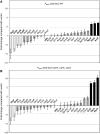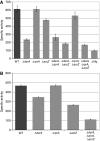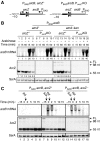Integrating anaerobic/aerobic sensing and the general stress response through the ArcZ small RNA
- PMID: 20683441
- PMCID: PMC2944060
- DOI: 10.1038/emboj.2010.179
Integrating anaerobic/aerobic sensing and the general stress response through the ArcZ small RNA
Abstract
The alternative sigma factor RpoS responds to multiple stresses and activates a large number of genes that allow bacteria to adapt to changing environments. The accumulation of RpoS is regulated at multiple levels, including the regulation of its translation by small regulatory RNAs (sRNAs). A library of plasmids expressing each of 26 Escherichia coli sRNAs that bind Hfq was created to globally and rapidly analyse regulation of an rpoS-lacZ translational fusion. The approach can be easily applied to any gene of interest. When overexpressed, four sRNAs, including OxyS, previously shown to repress rpoS, were observed to repress the expression of the rpoS-lacZ fusion. Along with DsrA and RprA, two previously defined activators of rpoS translation, a third new sRNA activator, ArcZ, was identified. The expression of arcZ is repressed by the aerobic/anaerobic-sensing ArcA-ArcB two-component system under anaerobic conditions and adds translational regulation to the ArcA-ArcB regulon. ArcZ directly represses, and is repressed by, arcB transcription, providing a negative feedback loop that may affect functioning of the ArcA-ArcB regulon.
Conflict of interest statement
The authors declare that they have no conflict of interest.
Figures







Similar articles
-
Hfq binding changes the structure of Escherichia coli small noncoding RNAs OxyS and RprA, which are involved in the riboregulation of rpoS.RNA. 2013 Aug;19(8):1089-104. doi: 10.1261/rna.034595.112. Epub 2013 Jun 26. RNA. 2013. PMID: 23804244 Free PMC article.
-
Mechanism for coordinate regulation of rpoS by sRNA-sRNA interaction in Escherichia coli.RNA Biol. 2020 Feb;17(2):176-187. doi: 10.1080/15476286.2019.1672514. Epub 2019 Sep 29. RNA Biol. 2020. PMID: 31552789 Free PMC article.
-
Mechanisms for Hfq-Independent Activation of rpoS by DsrA, a Small RNA, in Escherichia coli.Mol Cells. 2019 May 31;42(5):426-439. doi: 10.14348/molcells.2019.0040. Mol Cells. 2019. PMID: 31085808 Free PMC article.
-
Small non-coding RNAs, co-ordinators of adaptation processes in Escherichia coli: the RpoS paradigm.Mol Microbiol. 2003 May;48(4):855-61. doi: 10.1046/j.1365-2958.2003.03454.x. Mol Microbiol. 2003. PMID: 12753181 Review.
-
The small RNA regulators of Escherichia coli: roles and mechanisms*.Annu Rev Microbiol. 2004;58:303-28. doi: 10.1146/annurev.micro.58.030603.123841. Annu Rev Microbiol. 2004. PMID: 15487940 Review.
Cited by
-
RNA interactome of hypervirulent Klebsiella pneumoniae reveals a small RNA inhibitor of capsular mucoviscosity and virulence.Nat Commun. 2024 Aug 13;15(1):6946. doi: 10.1038/s41467-024-51213-z. Nat Commun. 2024. PMID: 39138169 Free PMC article.
-
C-terminal domain of the RNA chaperone Hfq drives sRNA competition and release of target RNA.Proc Natl Acad Sci U S A. 2016 Oct 11;113(41):E6089-E6096. doi: 10.1073/pnas.1613053113. Epub 2016 Sep 28. Proc Natl Acad Sci U S A. 2016. PMID: 27681631 Free PMC article.
-
Comparative analysis of regulatory elements between Escherichia coli and Klebsiella pneumoniae by genome-wide transcription start site profiling.PLoS Genet. 2012;8(8):e1002867. doi: 10.1371/journal.pgen.1002867. Epub 2012 Aug 9. PLoS Genet. 2012. PMID: 22912590 Free PMC article.
-
An atlas of Hfq-bound transcripts reveals 3' UTRs as a genomic reservoir of regulatory small RNAs.EMBO J. 2012 Oct 17;31(20):4005-19. doi: 10.1038/emboj.2012.229. Epub 2012 Aug 24. EMBO J. 2012. PMID: 22922465 Free PMC article.
-
Evolution of the metabolic and regulatory networks associated with oxygen availability in two phytopathogenic enterobacteria.BMC Genomics. 2012 Mar 22;13:110. doi: 10.1186/1471-2164-13-110. BMC Genomics. 2012. PMID: 22439737 Free PMC article.
References
-
- Aiso T, Ohki R (2003) Instability of sensory histidine kinase mRNAs in Escherichia coli. Genes Cells 8: 179–187 - PubMed
-
- Altuvia S, Weinstein-Fischer D, Zhang A, Postow L, Storz G (1997) A small, stable RNA induced by oxidative stress: role as a pleiotropic regulator and antimutator. Cell 90: 43–53 - PubMed
-
- Antal M, Bordeau V, Douchin V, Felden B (2005) A small bacterial RNA regulates a putative ABC transporter. J Biol Chem 280: 7901–7908 - PubMed
-
- Argaman L, Hershberg R, Vogel J, Bejerano G, Wagner EG, Margalit H, Altuvia S (2001) Novel small RNA-encoding genes in the intergenic regions of Escherichia coli. Curr Biol 11: 941–950 - PubMed
-
- Bongaerts J, Zoske S, Weidner U, Unden G (1995) Transcriptional regulation of the proton translocating NADH dehydrogenase genes (nuoA–N) of Escherichia coli by electron acceptors, electron donors and gene regulators. Mol Microbiol 16: 521–534 - PubMed
Publication types
MeSH terms
Substances
Grants and funding
LinkOut - more resources
Full Text Sources
Other Literature Sources
Molecular Biology Databases

